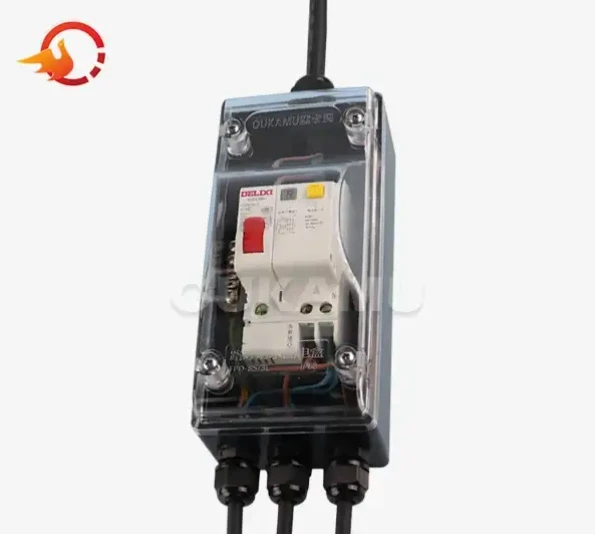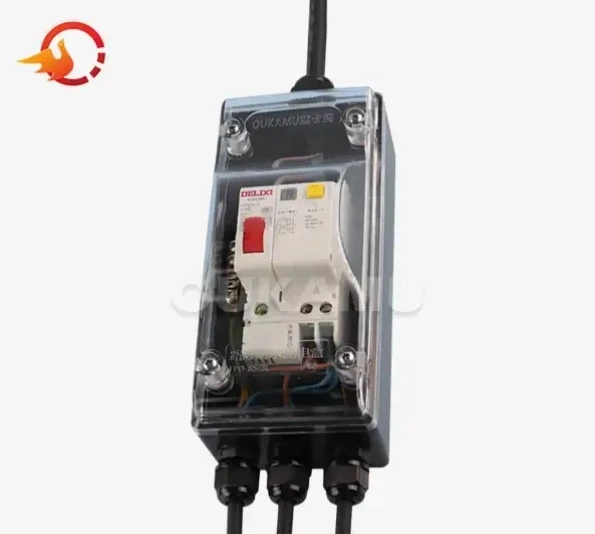Low voltage lighting systems are increasingly popular for both residential and commercial spaces. They offer numerous benefits, such as energy efficiency, flexibility, and enhanced safety. One of the most important components of these systems is the low voltage lighting distribution box. A distribution box acts as the central hub that manages the distribution of electricity to different parts of a lighting system. Properly designing and selecting a distribution box ensures optimal performance and safety.

In this blog, OUKAMU will dive into the pros and cons of low voltage lighting distribution boxes. By exploring the advantages and disadvantages, we’ll help you make an informed decision on whether such systems are right for your lighting setup. Whether you are designing a new system or upgrading an existing one, understanding the role of the distribution box will guide your choices and enhance system efficiency.
1. What Are Low Voltage Lighting Distribution Boxes and How Do They Work?
Before diving into the pros and cons, it's important to understand what a low voltage lighting distribution box is and how it functions. A distribution box in a low voltage lighting system serves as a central hub where electrical power is routed to various circuits, typically at a voltage below 50V, which is considered safe for indoor lighting systems. These boxes house vital electrical components such as:
- Transformers: Convert standard mains electricity (110V or 220V) to lower voltages for safe lighting use.
- Circuit Breakers: Protect the system by preventing overloads or short circuits.
- Fuses: Provide additional protection by disconnecting power during a fault.
- Connectors: Facilitate safe connections between different cables or fixtures.
The box ensures a safe, organized, and efficient flow of power to each connected light fixture or device. It provides a reliable system for distributing power without the risk of excessive heat, electrical failure, or fire hazards.
Advantages of Low Voltage Lighting Distribution Boxes
1. Energy Efficiency and Cost Savings
One of the primary advantages of using low voltage lighting distribution boxes is their ability to help reduce energy consumption. These systems are more energy-efficient compared to traditional high-voltage lighting systems. Low voltage lighting draws less current, resulting in less energy loss through heat generation and lower overall energy consumption.
For instance, LED lights connected to low voltage systems offer significant energy savings, consuming up to 80% less power than traditional incandescent bulbs. By integrating a low voltage distribution box, businesses and homeowners can save substantially on their electricity bills. The efficient distribution of power also minimizes the wear and tear on electrical components, extending the lifespan of the lighting fixtures and reducing maintenance costs.
Additionally, many low voltage systems are designed to be dimmable or adjustable, allowing users to further optimize energy usage based on actual lighting needs. This flexibility enhances energy efficiency, as lights can be dimmed or turned off in unused areas.
2. Enhanced Safety and Reduced Risks
Low voltage lighting systems are inherently safer than high-voltage lighting systems. The lower voltage used in these systems significantly reduces the risk of electrical shocks, which is especially important in residential and commercial settings. Distribution boxes play a key role in ensuring the system remains safe by providing an organized, secure way to manage electrical connections.
A well-designed distribution box incorporates several safety features, including:
- Circuit Breakers and Fuses: These components disconnect power in case of overloads or short circuits, preventing damage to the system or potential fire hazards.
- Heat Management: Distribution boxes are designed with adequate ventilation and insulation, reducing the risk of overheating.
This level of safety makes low voltage lighting systems ideal for applications in areas where traditional high-voltage systems would pose a greater risk, such as in outdoor or wet environments, children's rooms, and areas with limited electrical infrastructure.
3. Flexibility and Customization
Low voltage lighting distribution boxes allow for greater flexibility in lighting system design. These boxes can handle multiple circuits and lighting configurations, making it easier to customize the system based on specific needs. For example, you can group different lighting zones (e.g., general lighting, accent lighting, task lighting) and control them separately.
Additionally, low voltage lighting systems are more versatile when it comes to installation. They can be used with a variety of lighting fixtures, such as recessed lights, track lighting, and under-cabinet lighting, giving designers and homeowners the flexibility to choose the best lighting solutions for their space.
The use of OUKAMU’s Branch Cable, a revolutionary technology for branch cable connections, takes flexibility to the next level. This technology simplifies the process of creating secure, reliable connections between lighting fixtures, reducing installation time and effort.
4. Simplified Installation and Maintenance
Low voltage lighting distribution boxes typically require less complex installation compared to high-voltage systems. Wiring is easier to handle because the lower voltage reduces the risk of electrical shock during installation, allowing electricians and technicians to work more efficiently.
Maintenance is also simplified due to the organized nature of the distribution box. Regular inspections, such as checking for loose connections or faulty transformers, can be carried out quickly. In case of a fault, a low voltage distribution box allows for easy identification of problem areas, reducing the time spent troubleshooting and fixing issues.
The OUKAMU Branch Cable can further streamline maintenance by reducing the number of connection points in the system, minimizing the potential for faulty wiring and making the entire setup easier to maintain.
5. Scalability for Larger Systems
Low voltage lighting systems are highly scalable, making them suitable for both small and large-scale applications. Whether you are outfitting a small office or installing a complex lighting system for an entire building, low voltage lighting distribution boxes can accommodate different configurations and growth over time.
For example, when expanding or remodeling, additional fixtures can be added to the existing system without the need for major rewiring. The modular nature of the system ensures that each component can be upgraded or replaced independently without disturbing the overall setup.
Disadvantages of Low Voltage Lighting Distribution Boxes
1. Limited Power Handling Capacity
While low voltage lighting systems are highly efficient, they come with limitations in terms of power handling capacity. These systems are best suited for lighting and small electrical devices. For larger applications or high-wattage lights, the low voltage system might not provide the required power, necessitating the use of higher voltage circuits.
This limitation can be a disadvantage for large-scale commercial or industrial applications where high-powered lights or numerous fixtures are needed. In such cases, an additional power supply might be required to complement the low voltage system.
2. Higher Initial Setup Costs
Although low voltage lighting systems offer long-term savings, the initial setup costs can be higher than traditional high-voltage systems. The components, such as transformers, circuit breakers, and distribution boxes, may require a larger upfront investment. Additionally, the installation process can sometimes be more involved, requiring more specialized labor and expertise.
However, over time, these costs can be offset by energy savings and reduced maintenance needs. The long-term benefits often outweigh the initial investment, especially when considering the durability and reliability of the system.
3. Potential for Overloading and System Failures
If not designed or installed properly, low voltage lighting systems can be prone to overloading, particularly if too many fixtures are connected to a single distribution box. An overloaded system can cause damage to the wiring, transformers, or connectors, leading to failures or safety hazards.
To avoid such issues, it's crucial to ensure that the distribution box is sized correctly to handle the power requirements of the system. Proper installation, adherence to safety guidelines, and regular maintenance can minimize the risks associated with overloading.
4. Limited Compatibility with Existing High Voltage Systems
One of the challenges of using low voltage lighting distribution boxes is that they may not be compatible with existing high-voltage wiring systems. This may require additional work to retrofit the system, potentially increasing installation time and costs.
For buildings or homes with older electrical systems, upgrading to a low voltage lighting system may require a complete overhaul of the existing wiring, which could be inconvenient and expensive.
5. Vulnerability to Environmental Factors
Low voltage lighting systems can be more sensitive to environmental factors like moisture, dust, or extreme temperatures. Although distribution boxes are designed to be sealed and protected, prolonged exposure to harsh conditions may lead to wear and tear on components.
Proper installation in controlled environments, regular cleaning, and maintenance are essential to ensuring the longevity of the system. Using high-quality components like OUKAMU’s Branch Cable, which is designed to resist environmental wear, can help mitigate these risks.
Conclusion
Low voltage lighting distribution boxes offer a range of benefits, from energy efficiency and safety to flexibility and scalability. However, they also come with challenges, including higher initial costs and potential compatibility issues with older systems. Understanding both the pros and cons will help you determine whether a low voltage lighting system is the right choice for your needs.
By integrating innovative technologies like OUKAMU’s Branch Cable, which simplifies installation and ensures reliable connections, you can maximize the efficiency and performance of your low voltage lighting system. Whether you’re working on a residential, commercial, or industrial project, understanding the capabilities and limitations of low voltage systems will ensure a successful installation and long-term reliability.
For more information on OUKAMU’s Branch Cable and how it can enhance your lighting system, feel free to contact us at info@okmbranchcable.com.
References
- Lighting Systems Design: Low Voltage Lighting - Lighting Design Institute
- Low Voltage Electrical Systems - National Electrical Contractors Association (NECA)
- Energy Efficiency in Lighting - U.S. Department of Energy
- Electrical Wiring Systems - DIY Network
- Innovation in Cable Technology - OUKAMU Official Site


